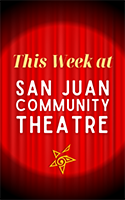Q&A with OPALCO Board of Directors candidate Jessa Madosky
Posted March 14, 2022 at 3:48 pm by San Juan Update
 Jessa Madosky is one of three candidates running for the open seat on the OPALCO Board of Directors that represents District 1, which includes San Juan Island. Voting opened on March 11 and runs through April 27. OPALCO asked each candidate more than a dozen questions related to key issues facing OPALCO and Rock Island Communications now and in the years ahead. The San Juan Update shares their answers here.
Jessa Madosky is one of three candidates running for the open seat on the OPALCO Board of Directors that represents District 1, which includes San Juan Island. Voting opened on March 11 and runs through April 27. OPALCO asked each candidate more than a dozen questions related to key issues facing OPALCO and Rock Island Communications now and in the years ahead. The San Juan Update shares their answers here.
OPALCO’s mission is to provide safe, reliable, sustainable and cost-effective essential utility services with a commitment to the utilization of renewable resources and carbon reduction. Which of these is most important to you and why?
The most important part of the OPALCO mission needs to be to provide sustainable essential utility services or ultimately the entire mission will be unsuccessful. Without providing essential services that are sustainable (both in terms of the environment and in terms of the community) we may be able to provide services for a short time, or provide services to only parts of the community that are well off, but without providing services that are both environmentally sustainable and sustainable for all of our community members we cannot ensure that everyone has access to essential services.
OPALCO load doubles in winter, but solar production output drops to 1/16 (of summer production) in winter. What new energy resources would you like OPALCO to consider for meeting winter load?
I would be interested in exploring wind energy, especially through low profile wind turbine systems and exploring tidal or wave energy. Obviously a full environmental analysis would be needed to avoid unintended consequences, but there have been huge advances in sustainable technologies and the islands have an abundance of both wind and water energy that can be utilized during the winter months.
Solar power requires a lot of sunny land for solar arrays. County land use codes favor preserving local rural character over solar on open land. How do you think about these potentially conflicting approaches to land use?
Solar power and local rural character are not mutually exclusive. Our barn for our three horses is lit by solar powered lights from a small solar panel on the barn roof that is barely noticeable. There are ample roofs that could house solar panels with proper support for installing solar panels on private property and solar panel installations can also be used in conjunction with grazing when properly designed. We can design systems that don’t conflict and can provide both environmental friendly power and help local farms with an additional source of income to ensure that our farmland is not lost forever.
OPALCO depends on hydropower from the mainland for more than 84% of its total power supply. How important is hydropower in your vision for a future energy supply in the islands?
Unfortunately, it is not sustainable to continue to depend on hydropower from the mainland for most of the power on the islands for a wide variety of reasons. First off, with the impacts of climate change on snowpack and temperature extremes, hydropower may become less reliable in the region just as power demands increase rapidly. Mainland suppliers may be forced to reduce power output or dramatically increase prices as we saw this winter. We also know that many of the dams used for power production need to be removed in order to ensure the survival of salmon and our beloved Southern Resident Killer Whales. Finally, relying on power from the mainland leaves us reliant on running very expensive cable through the ocean to the islands and leave us without power if that cable is ever damaged. We need to create resilient and redundant sources of renewable energy here on the islands to ensure that we are not dependent on, and at the mercy of, power companies that prioritize supplying power for their communities first.
It’s estimated that OPALCO’s load growth will double between now and 2050 due to the electrification of heating and transportation. Where should this new energy come from?
This new energy should be supplied by local renewable energy projects and investment.
Where should new renewable projects be located?
New renewable projects should be located on all the ferry served islands and should be dispersed with an upgraded smart grid system to ensure true local resilience. The latest research indicates that having a smart grid that can respond to local power needs and redundant renewable sources distributed across the landscape is the best way to provide resilient power to communities.
Will local resistance limit siting and permitting?
Potentially, but with increased transparency and communication I think the community is ready to embrace resilient island-produced energy.
Who pays for it?
We need to be proactive in working with local non-profits, city, county and state governments, and local business and landowners to seek diverse funding support for resilient renewable energy. There is a growing recognition of the importance of these systems, especially in rural areas and we need to be very proactive in seeking out government funding, grants, and collaborations to become a leader in resilient, community-focused energy programs.
OPALCO’s current rate structure collects revenue to cover fixed costs through the kWh (energy use) charge. As we become more energy efficient and embrace more renewable energy, OPALCO won’t collect enough kWh revenue to cover fixed costs. How would you address this rate structure dilemma?
Some of these fixed costs may actually be reduced by using grants and government funding to upgrade our systems to systems that are more efficient and more resilient. This will reduce the overall costs that need to be covered by kWh charges. In addition, funds that are currently set aside to repair or replace cables from the mainland could also be repurposed towards fixed costs if these become unnecessary due to creating a resilient system. Ideally, producing our own renewable energy will be lower cost that purchasing energy from the mainland and will have fewer spikes in pricing, but the upfront cost may require capital investment that should be supported by proactive grant writing, accessing state and federal funds for modernizing rural energy grids, and through fundraising. One option may also be an increase on property taxes for second homes – many locations have tax codes that allow for lower taxes for year-round residents but higher taxes for vacation homes.
The County Comprehensive Plan cites “energy independence” as a goal. What is your understanding of this goal? How would you achieve it?
Energy independence should mean sourcing our energy from renewable sources within the islands – independence from both unsustainable fossil fuel use and from buying our energy from the mainland. I would achieve this through a mix of redundant, distributed, renewable energy sources across the main ferry served islands and an upgraded grid system with better efficiency.
OPALCO is a non-profit cooperative. How would you propose to keep member’s power bills affordable?
I would propose to keep member’s power bills affordable by aggressively going after grants and government funding to upgrade our power grid and create local renewable energy sources. This would also allow the islands to become independent from mainland power sources that can increase costs during high demand and allow OPALCO to invest in renewable power generation on island instead of expensive cables to the mainland.
What is your vision for providing communication technology throughout SJ County?
We need to ensure that every household can affordably access both phone and highspeed internet. Like power, we should aggressively pursue grants and federal funding for rural connectivity. We are currently in a time period where there is a lot of support for rural access to high-speed internet due to changes in education and work from the COVID crisis and we need to make sure as a community that we are able to access funding while it is available.
Rock Island provides internet connections to nearly 50% of the OPALCO membership. How important is it to provide internet to the balance of our membership?
It is incredibly important for the community for there to be an equitable and inclusive distribution of high-speed internet and unfortunately we are not there yet. As we have all seen during the COVID crisis, we are increasingly dependent on being able to access high speed internet for education and certain higher paying jobs. If many of our residents are unable to access high speed internet it reduces both educational and employment opportunities, which makes it even harder for people to afford to live here year-round. There is growing recognition around the world that access to high speed internet has become an equity issue and this recognition also comes with funding if we are able to act quickly to ensure that our community is able to benefit from this current drive to ensure rural areas have access to high speed internet.
Who should pay for the cost of internet connections?
Ideally, we should be seeking out grant and government support for ensuring that all community members have equitable access to internet connections. Currently the “last mile” costs are far too expensive for many county residents. OPALCO should partner with the county and local non-profits to access grants and government programs designed to increase rural access to high-speed internet and use these funding sources to help reduce consumer costs, especially for lower income and year-round residents.
How would you assist Rock Island in realizing that vision?
I have extensive experience writing and collaborating on grants and would be excited to help lead the charge in securing grant and government funding to ensure equitable access to high-speed internet for county residents. As a scientist, I’m experienced in finding funding sources, finding funding partners, and working together to secure grants to make projects happen.
You can support the San Juan Update by doing business with our loyal advertisers, and by making a one-time contribution or a recurring donation.
Categories: Around Here










No comments yet. Be the first!
By submitting a comment you grant the San Juan Update a perpetual license to reproduce your words and name/web site in attribution. Inappropriate, irrelevant and contentious comments may not be published at an admin's discretion. Your email is used for verification purposes only, it will never be shared.